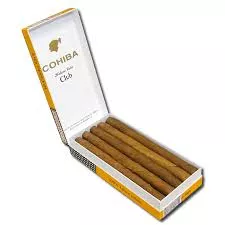Cohiba little cigars are manufactured by Internacional Cubana de Tabacos S.A. They belong to the premium segment.
What are the main differences between Cohiba little cigars and cigars of the same name?
Firstly, Cohiba little cigars have a smaller thickness and, accordingly, smoking time. A small diameter increases cravings, so the taste of cigarillos is different, even if tobacco of the same grade is used.
Cohiba little cigars are quite strong, although their diameter is only 8 mm.
Secondly, the filling of Cohiba little cigars consists of shredded tobacco, and not whole tobacco leaves. Moreover, the composition of one cigarillo may include several different varieties. The result is not a finely tuned mixture, as in cigars, but a heterogeneous gamma with a wide range of weakly expressed “notes”.
Thirdly, in the production of Cohiba little cigars, machine labor is used. The processes of blank formation are mechanized, which are then manually wrapped with a cover sheet.
Cohiba little cigars are produced in 2 formats: mini and club.
The Mini format is a small 8-centimeter cigarillo with a diameter of 20 RG (7.9 mm).
Club has a length of 97 mm (3.8 inches) and a diameter of 23 RG (9.1 mm). The smoking time of both cigarillos is only 10-15 minutes.
Cohiba little cigars have an original aroma and a mild recognizable taste. They are made in Cuba, which already speaks of the quality of tobacco. You cannot confuse the rich taste and aroma of tobacco leaf, which has grown on plantations in Cuba, a country with an ideal climate for this plant. Therefore, Cohiba little cigars are called the younger sister of the widely known cigars of the same name, which are made from the same raw materials. They are very similar in their taste and aromatic properties.
Cohiba little cigars are classified as elite tobacco products.
Their memorable taste is due to the use of tobacco triple fermentation, in contrast to the traditional double. After the third fermentation in oak barrels, the tobacco sheet finally gets rid of unwanted nitrates and resins, and the taste of the finished products becomes especially soft.
